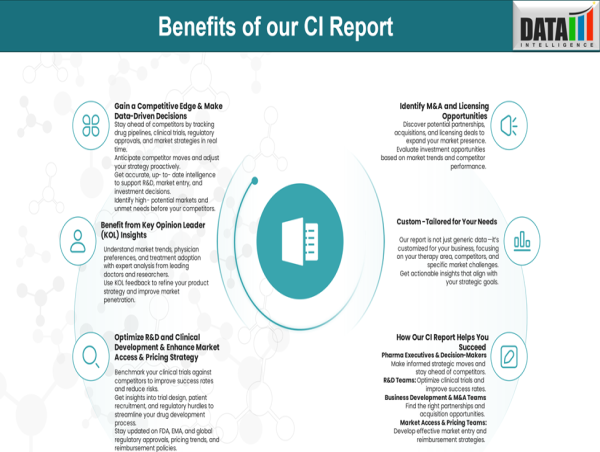Myelofibrosis (MF) is a complex bone marrow cancer marked by fibrosis, anemia, enlarged spleen, and debilitating symptoms. Driven largely by JAK2, CALR, or MPL mutations, its progressive bone marrow scarring disrupts blood cell production, causing anemia, cytopenias, and extramedullary hematopoiesis—especially in the spleen. Patients suffer from fatigue, night sweats, weight loss, and severe splenomegaly. Historically, treatment focused on symptom palliation, often via JAK inhibitors. But today, new therapies promise deeper responses—targeting anemia, thrombocytopenia, and even reversing fibrosis.
Download CI Sample Report: https://www.datamintelligence.com/strategic-insights/ci/myelofibrosis-mf
Disease Insights: Who Is Affected and Why This Matters
- MF affects roughly 0.5–1.5 people per 100,000 each year, equally in men and women.
- Primary MF can evolve from polycythemia vera or essential thrombocythemia.
- Symptoms not only reduce quality of life but also shorten survival, particularly if anemia or cytopenias are present.
- Long-term prognosis remains poor without decisive treatment, underscoring the need for better options.
Standard of Care: JAK Inhibitors Pave the Way
JAK inhibitors, particularly JAK1/JAK2 blockers, revolutionized MF care starting with ruxolitinib:
- Ruxolitinib (Jakafi) – First-line standard. It significantly reduces spleen size and symptoms, improving quality of life. However, anemia and thrombocytopenia limit its use in many patients.
- Fedratinib (Inrebic) – A second-line JAK2 inhibitor effective in patients intolerant to ruxolitinib.
- Pacritinib (Vonjo) – Effective even in patients with platelet counts under 50K/μL.
- Momelotinib (Ojjaara) – Blocks JAK1/JAK2 and ACVR1, uniquely improving anemia while controlling spleen size.
These JAK inhibitors remain essential in MF treatment, but they don't significantly change disease trajectory—fibrosis often persists, and responses can plateau.
Late-Stage Pipeline: Agents Aiming to Modify Disease
The push toward deeper, disease-modifying therapy has driven innovation beyond JAK blockade. Here's a breakdown:
- Pelabresib (BET inhibitor)
Combined with ruxolitinib in Phase III, it aims to diminish fibrosis and mutant allele burden, signaling true disease modification.
- Navtemadlin (MDM2 antagonist)
Aimed at ruxolitinib-refractory patients by activating p53 apoptosis pathways, it offers a non-JAK option targeting molecular drivers.
- Bomedemstat (LSD1 inhibitor)
This epigenetic modulator tackles both fibrosis and mutant burden, a dual threat to disease progression.
- Selinexor (XPO1 inhibitor)
By inhibiting nuclear export, it shows promise in patients who have failed JAK inhibitors.
- Imetelstat (Telomerase inhibitor)
Already showing survival benefits in refractory MF, it's among the first agents targeting the disease at the stem cell level.
- Ropeginterferon alfa-2b
A long-acting interferon in Phase III, it's being evaluated for early-stage MF with potential to achieve molecular remission.
Earlier stages host possible new frontiers—bispecifics, biologics, or CAR-T cell constructs—but late-stage agents shape today’s horizon.
Therapeutic Positioning: The Competitive Value Proposition
Ruxolitinib remains dominant due to broad approval and deep clinician experience. But its limitations—cytopenias, resistance, lack of disease modification—create opportunities for next-gen therapies.
Momelotinib and Pacritinib focus on specific unmet needs:
- Momelotinib greatly improves anemia with comparable spleen reduction.
- Pacritinib proves safer in thrombocytopenia, serving patients with low platelets.
Imetelstat, Pelabresib, Navtemadlin, Bomedemstat aim for deeper impact:
- Fibrosis reversal and allele burden reduction shift the goal from symptom relief to disease control.
- Potential survival benefits and combination therapy options are reshaping expectations.
Selinexor and ropeginterferon broaden reach to JAK failures and early-stage disease respectively.
Cumulatively, the pipeline aims to:
- Improve hematologic parameters
- Reverse bone marrow fibrosis
- Overcome JAK-resistance
- Offer long-term responses and possible cures
Target Opportunity Profile (TOP): What Patients and Payers Want
To stand out, therapies must deliver beyond current standards:
- Efficacy: Achieve ≥ 45% spleen volume reduction (SVR35) and ≥ 50% total symptom score (TSS50), sustained over time.
- Hematologic benefit: Improve anemia and reduce transfusions.
- Disease modification: Ideally reverse fibrosis or reduce JAK2 allele burden.
- Safety: Favorable profile in cytopenic patients; low GI or CNS side-effects.
- Convenience: Oral daily dosage (or SC/IV only if curative).
- Innovation: Novel targets and combination-ready profiles.
- Broad positioning: Effective as first‑line and in post‑JAK settings.
- Regulatory recognition: Endpoints like survival, fibrosis reversal, or transfusion independence.
Book Free CI Consultation Call: https://www.datamintelligence.com/strategic-insights/ci/myelofibrosis-mf
Market Opportunity & Forecast for 2025–2030
- Global MF prevalence and treatment uptake are expanding.
- Sales for Jakafi exceeded $2B in 2024; newer agents targeting subpopulations are expected to add several hundred million each.
- Combined, disease-modifying and non-JAK agents could reshape the market, especially in developing economies and for late-line patients.
- Payer pressure to shift from chronic JAK monotherapy toward finite-duration therapy exists—favorable for agents like imetelstat.
Challenges Remain
- Multifaceted trial design required—deep endpoints, longitudinal follow-up.
- Cost-effectiveness will weigh heavily—as annual oral therapy costs range from $150K to $250K+.
- Integration in clinical practice demands education on novel endpoints and sequencing.
- Managing cytopenias and long-term safety will drive real-world outcomes.
Conclusion: A Transformational Shift in MF Care
Myelofibrosis treatment has evolved from palliative symptom control toward molecularly informed, targeted therapy. The introduction of disease-modifying agents marks a transformative era. Treatment may no longer be lifelong and symptomatic: future regimens could combine JAK inhibitors with epigenetic drugs, telomerase inhibitors, or apoptosis enhancers—potentially setting new standards for remission and survival.
Every stage of treatment—from first-line to refractory disease—now has agents tailored to specific patient profiles. The journey continues—but the horizon is brighter than ever. Myelofibrosis care is evolving into a precision-driven, patient-centered, and outcome-focused model—and that progress matters for patients living with this condition.
Read Related CI Reports:
1. Non-Cystic Fibrosis Bronchiectasis | Competitive Intelligence
2. Waldenstrom Macroglobulinemia | Competitive Intelligence
Sai Kumar
DataM Intelligence 4market Research LLP
+1 877-441-4866
email us here
Visit us on social media:
LinkedIn
X
Legal Disclaimer:
EIN Presswire provides this news content "as is" without warranty of any kind. We do not accept any responsibility or liability for the accuracy, content, images, videos, licenses, completeness, legality, or reliability of the information contained in this article. If you have any complaints or copyright issues related to this article, kindly contact the author above.
![]()






